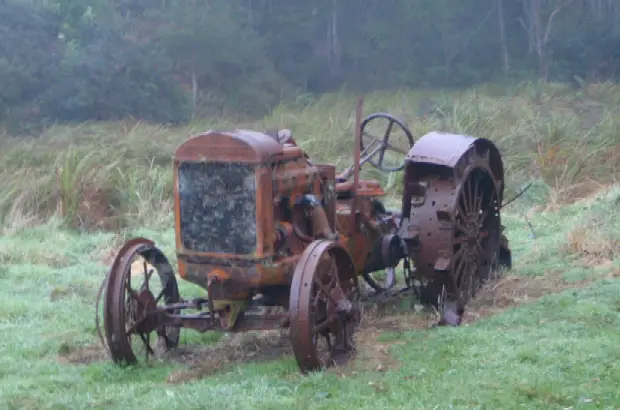


Rust Really Never Sleeps: Why You Need to Clean and Oil Firearms

If we could find a way to blame the condition of this tractor on primers or propellants, we'd likely do it. There are the usual suspects, but it isn't likely that gunpowder was involved.
What we casually call rust is orange iron oxide, though iron oxide comes in interesting color variations. Bluing is black oxide, a prettier version of rust. For bluing to work, it needs to be oiled. Most steels tarnish and corrode easily, gold and platinum being a couple of exceptions. Iron is reactive, reacting easily with oxygen and quicker yet with water. Naturally, water contains oxygen as well, a good thing if you are a fish, and the atmosphere contains water we like to call humidity. Relative humidity is talked about but rarely defined. It is actually the percentage of water vapor it can hold at a certain temperature. It varies with temperature, as air at 30 degrees C. can hold about 30 grams of water vapor per cubic meter of air. At 10 degrees C., it can hold only about 9 grams per cubic meter of air.
Oxygen reacting with unprotected metal causes rust. The orange flaky stuff drops off easily, exposing more iron and the process continues until there is essentially no iron left. Yet, the most common consumer “issue” according to two upscale, premium shotgun manufacturers is rust. You might think that the answer is obvious if not self-explanatory, but it seems that it isn't. Unprotected metals rusts and poorly protected metal rusts, whether it is formed into bicycles, roller skates, hand tools, automobiles, or firearms. We have paint, platings, dips, and various coatings to inhibit oxidation, but yet our stuff rusts. Put a scratch in plating or paint, there is a path for oxidation to occur and sooner or later, that's what normally happens.
The U.S. Federal Highway Commission's 2002 study, Corrosion Costs and Preventive Strategies in the United States, showed that for 1998 the total annual direct cost of corrosion in the U.S. was roughly 3.2% of the U.S. gross domestic product at $276 billion. It shouldn't surprise anyone that poorly maintained firearms rust. It seems to, though, and it is invariably the owner's fault. Unprotected metal is prone to corrosion.
We like to fool ourselves into thinking otherwise. We say that bad metal rusts and that just because we are using “non-corrosive” primers or propellants metal changes its properties. It doesn't, for most all the rusty bridges, signs, tools, trains, and automobiles in this country have not corroded due to primers or powders at all, whether billed as corrosive or non-corrosive. I can't begin to tell you the number of times that I've heard complaints about unprotected gun metal rusting and the blame is put on powder or primers, when no propellant I'm aware of is called a bore protectant or gun oil. No barrier to oxidation, we get oxidation.
Stainless steel is supposed to be rust-resistant, but it may rust. This gets into the notion of passivating metal, making the substrate less chemically reactive, or passive. Stainless steels with more than 11% chromium content are capable of forming the invisible, self-repairing oxide layer that makes it less prone to corrosion. Contamination during heat treat, machining, and finishing can prevent passivation from taking place. Specifics vary, but 410 and 416 stainless steels have in the area of 13% chromium content.
We also don't like the thicker greases and coatings that come on many new firearms. Sure, thick oils and greases can make firearms balky, but it beats the alternative of having new guns coming out of the box with rust as an added bonus. Bluing itself began as a desirable metal treatment for firearms as it is thin, not interfering with the function of close-fitting parts. A thorough cleaning is often required, though, if we want all-climate reliability in a new firearm, particularly with autoloaders.
Muzzleloading hunters seem to be particularly adept at rusting muzzleloaders. Black powder and Pyrodex as propellants have long had their detractors due to both the caustic nature of the residue and the hygroscopicity, or moisture-attracting properties, of the propellants. Yet, residue from any propellant is no bore protectant, and is not an effective barrier against moisture. Heat and pressure strips metal during the firing sequence, it does not leave an oil film in its place.
Stainless steel can mitigate and slow damage, but still if we want our guns to last it means cleaning them and adding a proper barrier to otherwise unprotected metal. Too soon we grow old, too late we get smart. Yes, I've allowed things to rust over the years that I didn't want rusted. Not being excessively smart, the key part is “I allowed.” Nobody makes us clean and oil our firearms after using them, so we often don't. It can be an expensive habit, though. Not cleaning and maintaining firearms is like working in the glue factory: if you don't watch out, you get stuck.
I'm not always in the mood to clean guns. Sometimes, everything I touch seems to break . . . now, I'm afraid to go to the bathroom. Nevertheless, as the years go by, guns now get cleaned and lubed invariably, soon after using them. Surprise, surprise . . . I no longer have any guns starting to rust. Coincidence? I think not.
Copyright 2010 by Randy Wakeman. All Rights Reserved.

Custom Search

